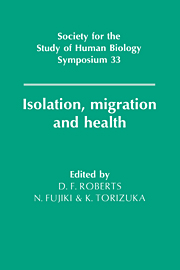Book contents
- Frontmatter
- Contents
- List of contributors
- Preface
- 1 The legacy of the IBP: Presidential Address
- 2 The distinction between primary and secondary isolates
- 3 Time trends in the break-up of isolates
- 4 Factors influencing the frequency of consanguineous marriages in Japan
- 5 Break-up of isolates
- 6 Isolates in India: their origin and characterisation
- 7 Consanguineous marriages and their genetical consequences in some Indian populations
- 8 Biomedical and immunogenetic variation in isolated populations in India
- 9 Genetic distance analyses in Israeli groups using classical markers and DNA polymorphisms in the β globin gene
- 10 Non-random distribution of Gm haplotypes in northern Siberia
- 11 Allele frequency estimation
- 12 Genetic affinities of human populations
- 13 Inherited neurological diseases in island isolates in southern Japan
- 14 Serological and virological evidence for human T-lymphotropic virus type I infection among the isolated Hagahai of Papua New Guinea
- 15 Analysis of genes associated with hypercholesterolaemia in the Japanese population
- 16 Migrant studies and their problems
- 17 Tokelau: migration and health in a small Polynesian society - a longitudinal study
- 18 Micromigrations of isolated Tuareg tribes of the Sahara Desert
- 19 Population structure in the eastern Adriatic: the influence of historical processes, migration patterns, isolation and ecological pressures, and their interaction
- 20 Diabetes and diabetic macroangiopathy in Japanese-Americans
- 21 Diabetes and westernisation in Japanese migrants
- 22 Environmental factors affecting ischemic heart disease
- Epilogue
- Index
11 - Allele frequency estimation
Published online by Cambridge University Press: 05 March 2012
- Frontmatter
- Contents
- List of contributors
- Preface
- 1 The legacy of the IBP: Presidential Address
- 2 The distinction between primary and secondary isolates
- 3 Time trends in the break-up of isolates
- 4 Factors influencing the frequency of consanguineous marriages in Japan
- 5 Break-up of isolates
- 6 Isolates in India: their origin and characterisation
- 7 Consanguineous marriages and their genetical consequences in some Indian populations
- 8 Biomedical and immunogenetic variation in isolated populations in India
- 9 Genetic distance analyses in Israeli groups using classical markers and DNA polymorphisms in the β globin gene
- 10 Non-random distribution of Gm haplotypes in northern Siberia
- 11 Allele frequency estimation
- 12 Genetic affinities of human populations
- 13 Inherited neurological diseases in island isolates in southern Japan
- 14 Serological and virological evidence for human T-lymphotropic virus type I infection among the isolated Hagahai of Papua New Guinea
- 15 Analysis of genes associated with hypercholesterolaemia in the Japanese population
- 16 Migrant studies and their problems
- 17 Tokelau: migration and health in a small Polynesian society - a longitudinal study
- 18 Micromigrations of isolated Tuareg tribes of the Sahara Desert
- 19 Population structure in the eastern Adriatic: the influence of historical processes, migration patterns, isolation and ecological pressures, and their interaction
- 20 Diabetes and diabetic macroangiopathy in Japanese-Americans
- 21 Diabetes and westernisation in Japanese migrants
- 22 Environmental factors affecting ischemic heart disease
- Epilogue
- Index
Summary
The genetic structure of a human population can be described in terms of two principal parameters: the inbreeding coefficient and gene frequency array. The inbreeding coefficient specifies the correlation between uniting gametes, and therefore alleles, in a given gene pool. Allele or gene frequency is a fundamental quantity by which to describe the wide occurrence of genetic polymorphisms in man. Recent advances in molecular biology have confirmed the existence of multiple alleles at a single locus, as well as multiple loci which are linked on the same chromosome.
This paper attempts to unify formulae for estimating allele frequency from population samples, by a counting method. It also presents quantities expressed in terms of allele frequencies, polymorphic information content (PIC) and probability of paternity exclusion (PE). These are of interest in genetic epidemiology.
With desktop computers there is little difficulty in using mathematically quite sophisticated methods such as maximum likelihood, but handy formulae are still indispensable and sound algorithms are required. Many genetic systems can now be treated as codominant, but some are still complicated by dominance. In the following, calculation procedures are given using codominant systems and the ABO-like systems.
Allele frequency estimations
The codominant system
Consider a locus A, with two alleles A1 and A2. Let the frequency of Ai be pi (i = 1 and 2). The expected frequency of the three genotypes, A1A1, A2A2 and A1A2, in a random mating population, will be p12, P22 and 2p1P2, respectively.
- Type
- Chapter
- Information
- Isolation, Migration and Health , pp. 112 - 117Publisher: Cambridge University PressPrint publication year: 1992



